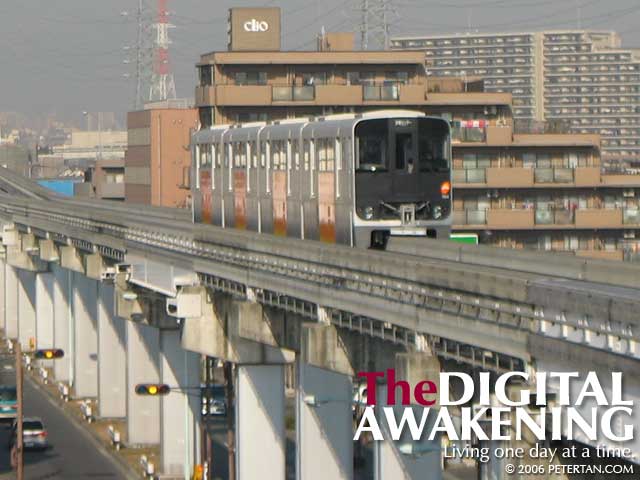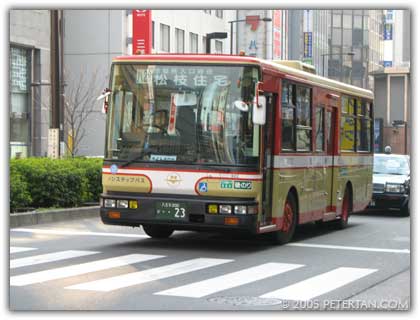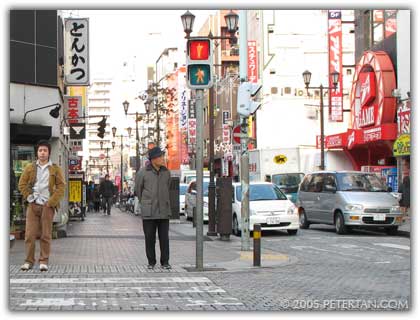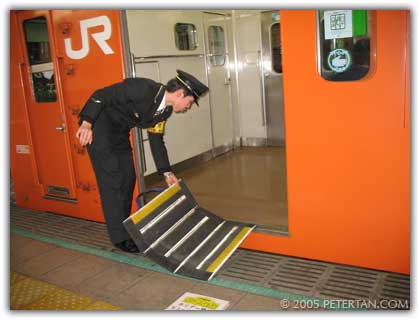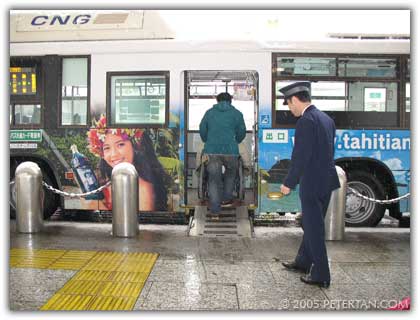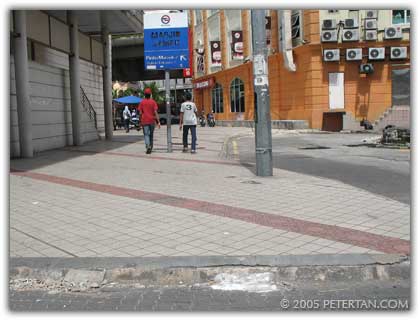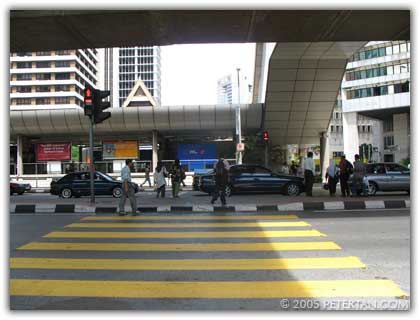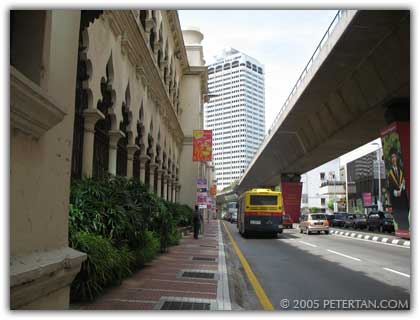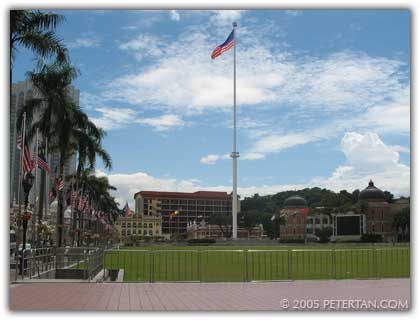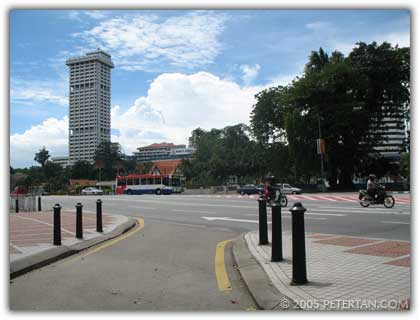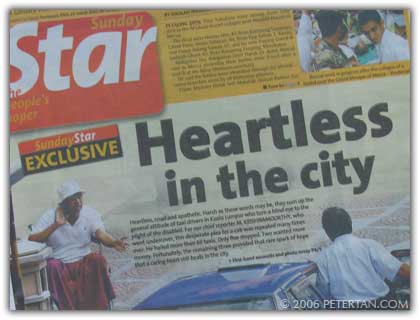
The Star – January 8, 2006
The headlines in today’s The Star screamed “Heartless In The City.” Chief Reporter M. Krishnamoorthy, spent one day on a wheelchair, trying to hail taxis in various part of Kuala Lumpur.
The article was sparked off by a letter from a reader in Penang. It was a heart-wrenching account of how difficult it was for him, who is *wheelchair-bound (sic), to get a taxi to stop.
This is what The Star’s M. Krishnamoorthy together with journalism trainee Vincent Tan and photographer Low Lay Phon discovered when Krishnamorthy posing as disabled person on a wheelchair tried to hail taxis at Kl Sentral, Bukit Bintang, Kota Raya and Salak South:
Only one in 12 taxis that I tried to flag down stopped for someone in a wheelchair. The others just drove by.
All in all, I tried to flag down almost 60 taxis. Only five taxi drivers stopped to ask where I wanted to go.
Of the five, two tried to swindle me.
This is all very true. There are taxi drivers who discriminate and there are the devious few who make the other honest and hardworking cabbies look bad. If in Kuala Lumpur, where there are thousands of taxis plying the roads, getting a taxi is such a big problem, imagine how it would be like for wheelchair users in other parts of the country to move around where there are less taxis.
Ahmad Yahaya, A. Raj and Wong Kam Sang are proof that not all taxi drivers are heartless. They are the few who have no qualms in picking up passengers using wheelchairs. Ahmad’s words were especially heart-warming:
“I always stop and pick up disabled people because they are special people.
In fact, I make it a point to look out for the disabled because I am fortunate to be able to walk and drive a taxi.
Therefore, it is my duty to take anyone who wants to ride in my taxi.
When I see a disabled person, I am thankful and grateful to serve that person.
I can take you anywhere you want to go, and even buy the coupon for you from the counter.”
In Penang, do not expect the taxi drivers to use the meters. Do not even attempt to hop into one before asking about the fare. They usually charge RM10 for short distances. Ask them to use the meter and expect to get dirty looks and nasty replies. Other modes of public transportation are in shambles, as admitted by Chief Minister Tan Sri Dr. Koh Tsu Khoon. Imagine how difficult it is for a disabled person in Penang to go out. This is reflected by Yeap Chin Chunya, a web designer, and Tan Kuan Aw, Deputy President of the Society of Disabled Persons Penang in the same report. Both are the few advocating accessibility and transportation for people with disabilities in Penang.
At the moment, there is only one group in the Klang Valley catering to the transportation needs of people with disabilities. Mobiliti, an association based in Petaling Jaya, charges RM3 per trip for their door-to-door transport service. They have three vans fitted with hydraulic lifts and wheelchair restraint systems. One van can usually accomodate three wheelchairs. Reservation is usually needed as the service is fully booked many days in advance.
Other organisations and institutions serving people with disabilities have lift-equipped vans or buses. However these vehicles are limited to the use of their own members or inmates only and are not open to the public. Unless the government takes the initiative to draw up a public transportation masterplan that includes the needs of people with disabilities, this problem will go on and prevent many in the disabled community from becoming contributing members of society and lead meaningful lives.
Related entry:
Ikea, Ikano Power Centre and The Curve
The following are todays articles from The Star.
Disabled, ignored and exploited
WHEN our local taxi drivers see a disabled person trying to flag them down, more often than not, they turn a blind eye.
“If you are a disabled person, chances are you will go unnoticed in Kuala Lumpur”, is what the disabled have been telling the media and friends.
We put this to the test to gauge whether cabbies are sensitive to the needs of the disabled.
I went undercover in a wheelchair around the city for four hours. And I found out … Yes! Taxi drivers pretend that a disabled person in a wheelchair does not exist. They look the other way.
Only one in 12 taxis that I tried to flag down stopped for someone in a wheelchair. The others just drove by.
All in all, I tried to flag down almost 60 taxis. Only five taxi drivers stopped to ask where I wanted to go.
Of the five, two tried to swindle me.
“If I take you to Kajang, I will have to return empty. So I have to charge you both ways. One way is RM30, so the fare is RM60,” said one.
Another cabbie at the Bintang Walk, stopped and ogled at a foreign tourist and boasted that he had made love to almost all nationalities who were his passengers in the past 12 years.
He went on for 10 minutes and then parted with a word of caution: “Tell all your friends not to let their daughters marry a taxi driver.”
My undercover work started at 10am when The Star van dropped me off at the Hilton Hotel car park, and I tried to wheel myself across to the taxi stand at KL Sentral.
A policeman who saw me struggling rushed over and helped me across the road dividers.
There were about 10 taxis waiting in single file for passengers. I tried to hail them but they ignored me.
Of the 23 taxis I tried to stop at KL Sentral, only two stopped to ask where I wanted to go.
Ahmad Yahaya, 43, said he was willing to take me to Kajang.
“If you wait here, I will go and get you a coupon and I can take you to Kajang.”
“Can my wheelchair fit in your taxi?” I asked him, and he said, “No problem. I have taken wheelchair-bound passengers before.
“It is my duty to take anyone who wants to go in a taxi. Thank you for stopping me and asking me to give you a ride,” he said.
Ahmad was a helpful taxi driver and I could see his enthusiasm in wanting to help a disabled person.
In contrast, the majority of taxi drivers ignored the disabled. Many of them pretended to talk on the mobile phone, covered their face behind a newspaper or just ignored me and drove away.
My next stop was the Kota Raya bus stand.
Just like the taxi drivers at KL Sentral, the cabbies here did not look at me.
However, one taxi driver responded.
As he walked towards me, he asked me: “Where do you want to go?”
I said: “Rawang”.
“Okay! But it will cost you double.”
I asked him why and his reply was the same as the earlier taxi driver.
After lunch, I sat patiently by the main road next to the Salak South post office and of the nine taxis I tried to stop, only one did.
The driver, Wong Kam Sang, 67, was prepared to take me. But because I was supposedly heading to Rawang, he apologised for not being able to do so as he had a prior appointment in 20 minutes.
I told him I understood and appreciated the fact that he cared enough to stop.
The rain came soon after and it was time to call it a day.
Despite the bleak conclusion about how heartless the city is with regard to the transport needs of the disabled, I saw a ray of hope in people like Wong and Ahmad.
Reliant on regular cabby
PENANG: Wheelchair-bound Yeap Chin Chunya only leaves his apartment in Jalan Bagan Jermal a few times a month because of difficulty using public transport.
When he does need to go out, Yeap, 42, will call his regular taxi driver, Ah Guan, or a taxi company named Ticcom Agency.
“Many cabbies won’t take people in wheelchairs because they don’t know how to handle us and are afraid of us.
“When I call a taxi company, I must first let them know my condition as I will need to be carried into the taxi. It is up to them whether to take me,” said Yeap, a web designer for the Society for Disabled Persons Penang.
Society for Disabled Persons Penang deputy president Tan Kuan Aw, 52, said although there are taxi drivers who are helpful to the disabled, it was still expensive for the disabled to depend on taxis all the time.
“Buses in Penang are unsuitable for the wheelchair-bound. It is unthinkable to even try (using them),” said Tan.
Access a big problem
PETALING JAYA: The biggest problem disabled Malaysians face more than anything else is accessibility to public transportation.
“That is the one reason why disabled Malaysians are mostly jobless,” said Anthony Thanasayan (pictured here with his guide dog, Soolam), an advocate for the disabled who writes the weekly column Wheel Power in The Star.
“Even when a kind soul out there is willing to offer a disabled person a job, there is just no way for him to get there in time or even get there at all,” he added.
Public transport facilities like the LRT are disabled-friendly but getting to the various stations still require, in most cases, a taxi.
“Even if one does stop, the driver will try to take advantage of the situation because they know just how vulnerable we are,” he said.
